Solar eclipse of October 2, 2024
An annular solar eclipse will occur on October 2, 2024. A solar eclipse occurs when the Moon passes between Earth and the Sun, thereby totally or partly obscuring the image of the Sun for a viewer on Earth. An annular solar eclipse occurs when the Moon's apparent diameter is smaller than the Sun's, blocking most of the Sun's light and causing the Sun to look like an annulus (ring). An annular eclipse appears as a partial eclipse over a region of the Earth thousands of kilometres wide.
| Solar eclipse of October 2, 2024 | |
|---|---|
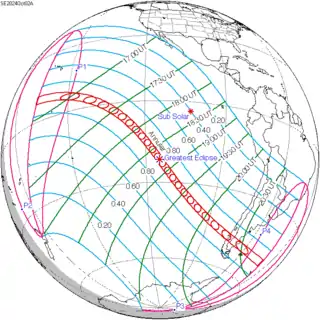 Map | |
| Type of eclipse | |
| Nature | Annular |
| Gamma | -0.3509 |
| Magnitude | 0.9326 |
| Maximum eclipse | |
| Duration | 445 sec (7 m 25 s) |
| Coordinates | 22°S 114.5°W |
| Max. width of band | 266 km (165 mi) |
| Times (UTC) | |
| Greatest eclipse | 18:46:13 |
| References | |
| Saros | 144 (17 of 70) |
| Catalog # (SE5000) | 9562 |
Other than Easter Island and a small portion near the southern tips of Argentina and Chile, the path of the eclipse's antumbra will be entirely over the Pacific Ocean. The penumbra will be visible from southern South America, Hawaii and portions of Antarctica. Eclipse magnitude is 0.93261, occurring only 56 minutes before apogee.
Images
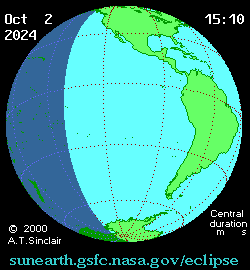
Animated path
Related eclipses
Eclipses of 2024
Solar eclipses of 2022–2025
This eclipse is a member of a semester series. An eclipse in a semester series of solar eclipses repeats approximately every 177 days and 4 hours (a semester) at alternating nodes of the Moon's orbit.[1]
| Solar eclipse series sets from 2022–2025 | ||||||
|---|---|---|---|---|---|---|
| Ascending node | Descending node | |||||
| Saros | Map | Gamma | Saros | Map | Gamma | |
| 119 | 2022 April 30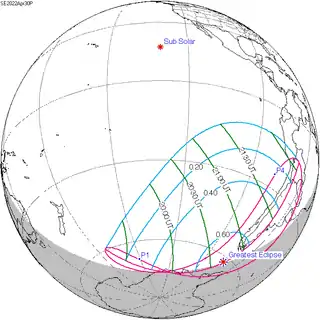 Partial | -1.19008 | 124 | 2022 October 25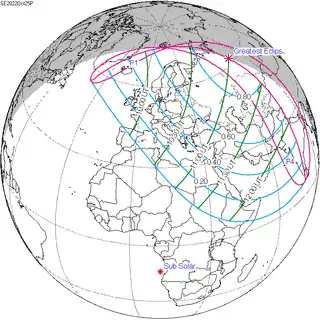 Partial | 1.07014 | |
| 129 | 2023 April 20 Hybrid | -0.39515 | 134 | 2023 October 14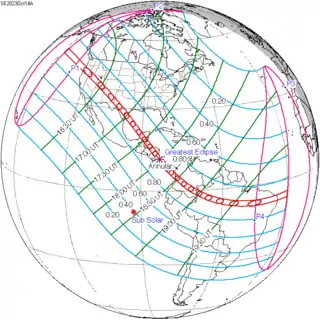 Annular | 0.37534 | |
| 139 | 2024 April 8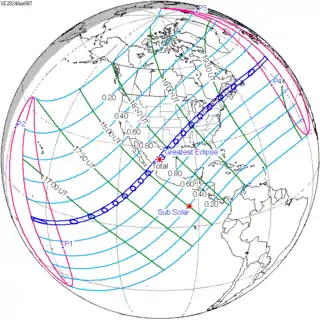 Total | 0.34314 | 144 | 2024 October 2 Annular | -0.35087 | |
| 149 | 2025 March 29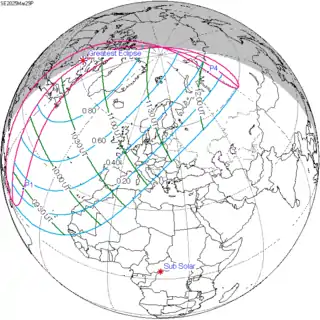 Partial | 1.04053 | 154 | 2025 September 21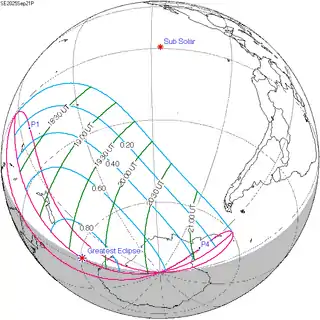 Partial | -1.06509 | |
Saros 144
It is a part of Saros cycle 144, repeating every 18 years, 11 days, containing 70 events. The series started with partial solar eclipse on April 11, 1736. It contains annular eclipses from July 7, 1880 through August 27, 2565. There are no total eclipses in the series. The series ends at member 70 as a partial eclipse on May 5, 2980. The longest duration of annularity will be 9 minutes, 52 seconds on December 29, 2168.
| Series members 11–21 occur between 1901 and 2100: | ||
|---|---|---|
| 11 | 12 | 13 |
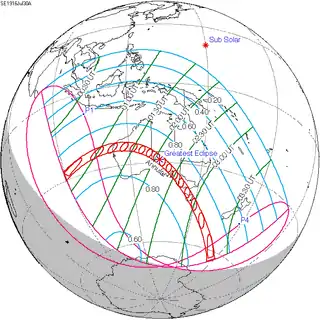 Jul 30, 1916 |
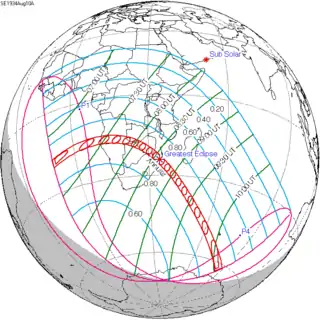 Aug 10, 1934 |
 Aug 20, 1952 |
| 14 | 15 | 16 |
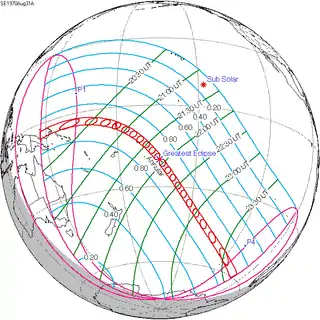 Aug 31, 1970 |
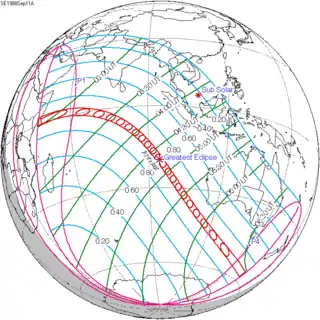 Sep 11, 1988 |
 Sep 22, 2006 |
| 17 | 18 | 19 |
 Oct 2, 2024 |
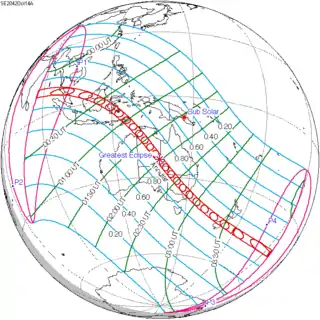 Oct 14, 2042 |
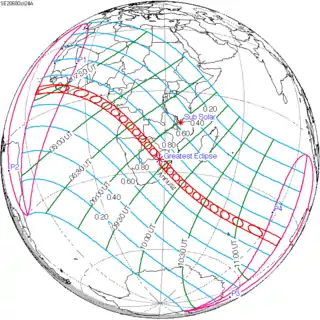 Oct 24, 2060 |
| 20 | 21 | |
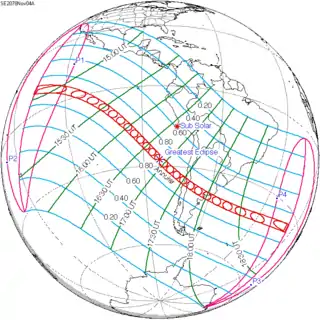 Nov 4, 2078 |
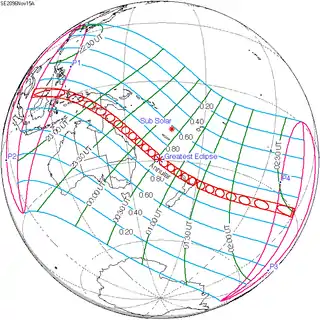 Nov 15, 2096 | |
Tritos series
This eclipse is a part of a tritos cycle, repeating at alternating nodes every 135 synodic months (≈ 3986.63 days, or 11 years minus 1 month). Their appearance and longitude are irregular due to a lack of synchronization with the anomalistic month (period of perigee), but groupings of 3 tritos cycles (≈ 33 years minus 3 months) come close (≈ 434.044 anomalistic months), so eclipses are similar in these groupings.
| Series members between 1901 and 2100 | |||
|---|---|---|---|
 September 9, 1904 (Saros 133) |
 August 10, 1915 (Saros 134) |
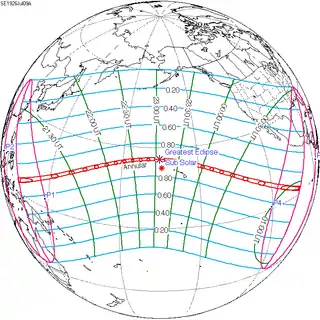 July 9, 1926 (Saros 135) | |
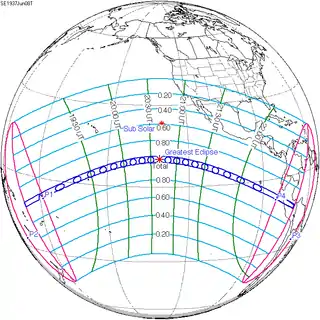 June 8, 1937 (Saros 136) |
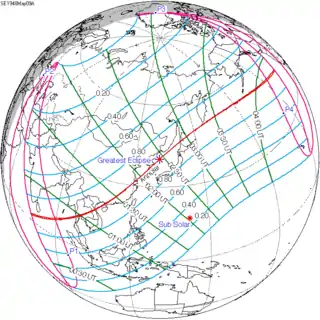 May 9, 1948 (Saros 137) |
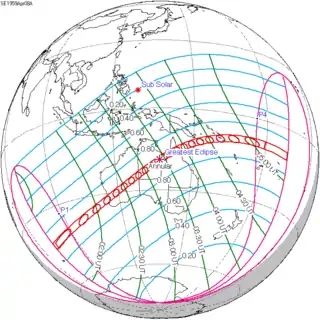 April 8, 1959 (Saros 138) | |
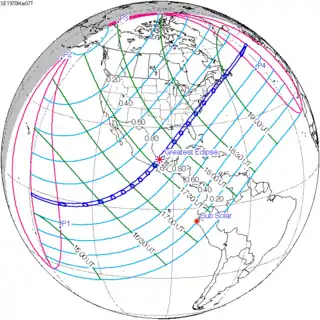 March 7, 1970 (Saros 139) |
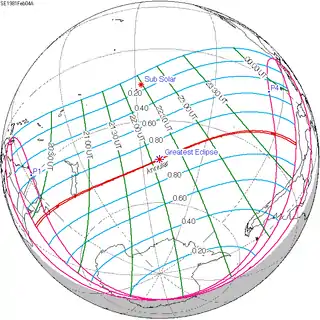 February 4, 1981 (Saros 140) |
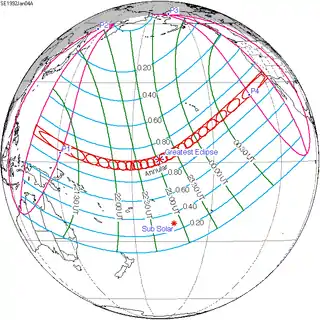 January 4, 1992 (Saros 141) | |
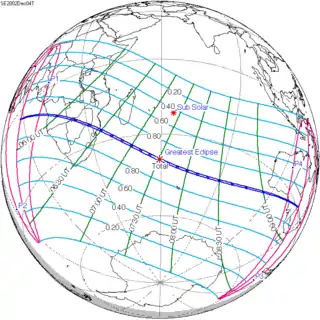 December 4, 2002 (Saros 142) |
 November 3, 2013 (Saros 143) |
 October 2, 2024 (Saros 144) | |
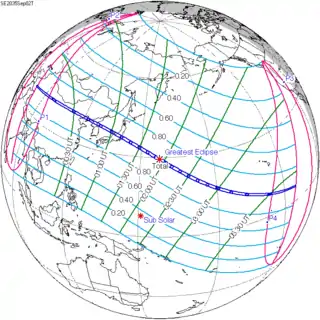 September 2, 2035 (Saros 145) |
 August 2, 2046 (Saros 146) |
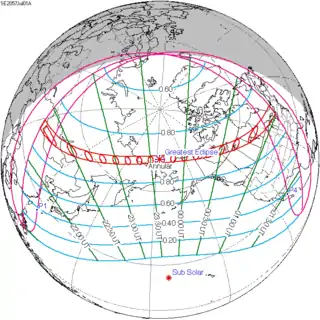 July 1, 2057 (Saros 147) | |
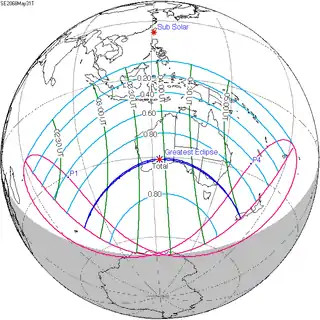 May 31, 2068 (Saros 148) |
 May 1, 2079 (Saros 149) |
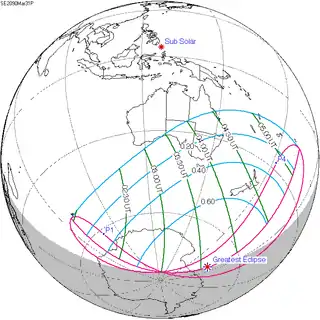 March 31, 2090 (Saros 150) | |
Metonic cycle
The metonic series repeats eclipses every 19 years (6939.69 days), lasting about 5 cycles. Eclipses occur in nearly the same calendar date. In addition, the octon subseries repeats 1/5 of that or every 3.8 years (1387.94 days). All eclipses in this table occur at the Moon's descending node.
| 21 events between July 22, 1971 and July 22, 2047 | ||||
|---|---|---|---|---|
| July 21–22 | May 9–11 | February 26–27 | December 14–15 | October 2–3 |
| 106 | 108 | 110 | 112 | 114 |
| July 21, 1952 | May 10, 1956 | February 26, 1960 | December 16, 1963 | October 3, 1967 |
| 116 | 118 | 120 | 122 | 124 |
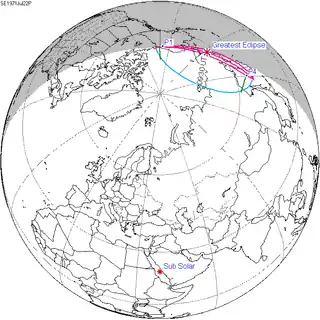 July 22, 1971 |
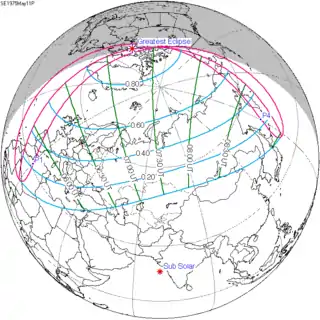 May 11, 1975 |
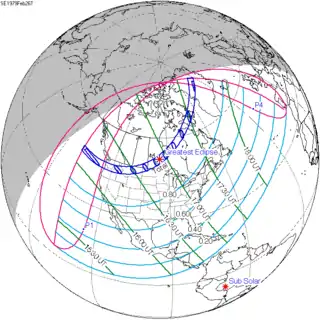 February 26, 1979 |
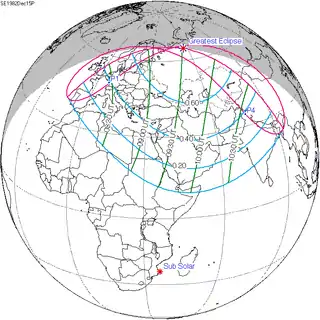 December 15, 1982 |
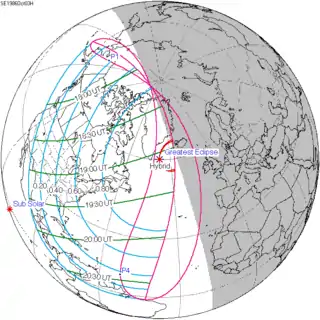 October 3, 1986 |
| 126 | 128 | 130 | 132 | 134 |
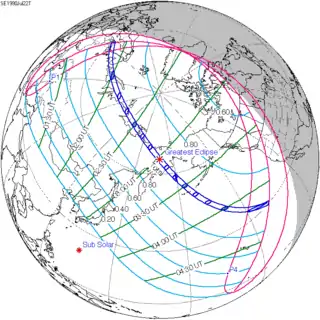 July 22, 1990 |
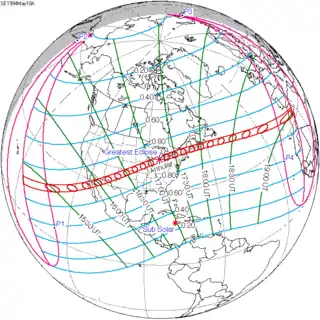 May 10, 1994 |
 February 26, 1998 |
 December 14, 2001 |
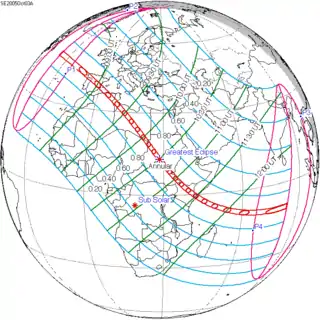 October 3, 2005 |
| 136 | 138 | 140 | 142 | 144 |
 July 22, 2009 |
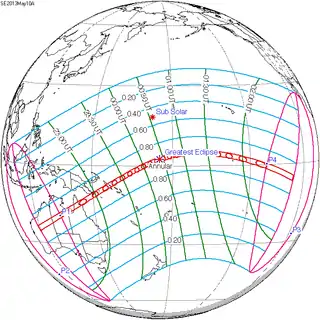 May 10, 2013 |
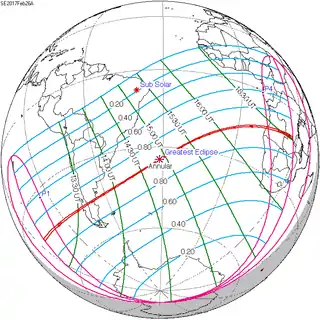 February 26, 2017 |
 December 14, 2020 |
 October 2, 2024 |
| 146 | 148 | 150 | 152 | 154 |
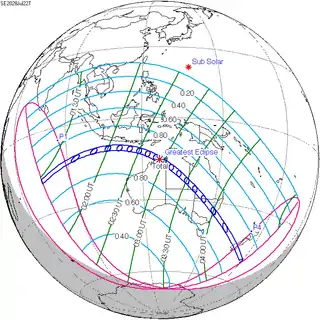 July 22, 2028 |
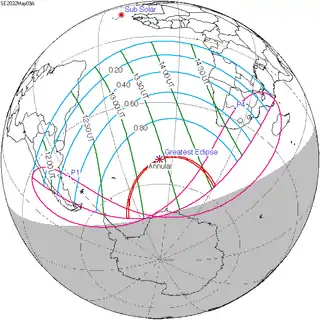 May 9, 2032 |
 February 27, 2036 |
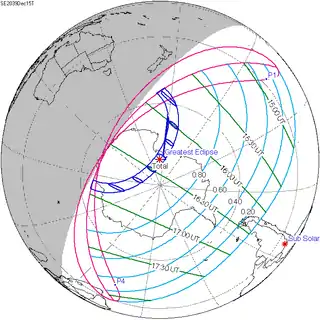 December 15, 2039 |
 October 3, 2043 |
| 156 | ||||
 July 22, 2047 | ||||
References
- van Gent, R.H. "Solar- and Lunar-Eclipse Predictions from Antiquity to the Present". A Catalogue of Eclipse Cycles. Utrecht University. Retrieved 6 October 2018.
| Wikimedia Commons has media related to Solar eclipse of 2024 October 2. |
External links
- Earth visibility chart and eclipse statistics Eclipse Predictions by Fred Espenak, NASA/GSFC
.jpg.webp)

